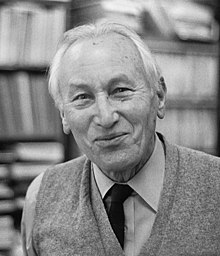| Kenneth Vivian Thimann | |
|---|---|
 | |
| Born | August 5, 1904 Ashford, Kent, England |
| Died | January 15, 1997 Haverford, Pennsylvania, United States |
| Monuments | Thimann Laboratories, University of California at Santa Cruz |
| Spouse(s) | Ann Mary Thimann, nee Augusta Mary Bateman (b.4/20/1905 d.1987) |
| Children | Vivianne T. Nachmias, Karen T. Romer, Linda T. Dewing |
| Parents |
|
| Relatives | Siblings: Ralph Thimann, Eric Thiman, and Ivor Cedric Thimann |
Kenneth Vivian Thimann (August 5, 1904 – January 15, 1997) was an English-American plant physiologist and microbiologist known for his studies of plant hormones, which were widely influential in agriculture and horticulture. He isolated and determined the structure of auxin, the first known plant hormone. He spent most of his early career (1935–1965) at Harvard University, and his later career (1965 - 1989) at the University of California, Santa Cruz. He is credited with identifying indole-3-acetic acid as an auxin.
Thimann was born in Ashford, England. He studied chemistry and biochemistry at Imperial College, University of London (earning a B.Sc. and a Ph.D.) and also received a diploma from the University of Graz. After several years teaching at the University of London, Thimann moved to the California Institute of Technology in 1930. In 1935, he joined the Biology department of Harvard University. He authored an influential book on plant hormones, Phytohormones, in 1937 (co-authored with F. W. Went). He was elected to the American Academy of Arts and Sciences in 1938. Thimann became director of Harvard's Biological Laboratories in 1946, a position he held until 1950. He was elected to the United States National Academy of Sciences in 1948. In 1955 he wrote The Life of Bacteria, an influential book on microbiology. He was elected to the American Philosophical Society in 1959. From 1962 until leaving Harvard in 1965, Thimann was the Higgins Professor of Biology.
Thimann moved to University of California, Santa Cruz (UCSC) in 1965—the year of its founding—to become the first provost of Crown College. At UCSC, he was largely responsible for building the science departments of the new university. He also played a central role in fostering the UCSC Arboretum and its botanical collection. After retiring as provost in 1972, Thimann remained at UCSC until 1989, when he moved to Haverford, Pennsylvania. In 1977, he wrote Hormone Action in the Whole Life of Plants. He won the Balzan Prize in 1982 in recognition of his contributions to botany.
Notes and references
- ^ Charles Daniel, "Kenneth V. Thimann, Biology: Santa Cruz", University of California: In Memoriam, 1997, edited by David Krogh. Academic Senate, University of California, 1997, pp. 163-165. Accessed March 5, 2009.
- Thimann, Kenneth V. (1936). "Auxins and the Growth of Roots". American Journal of Botany. 23 (8): 561–569. doi:10.2307/2436087. JSTOR 2436087.
- "Kenneth Vivian Thimann". American Academy of Arts & Sciences. Retrieved 2022-12-07.
- "Kenneth V. Thimann". www.nasonline.org. Retrieved 2022-12-07.
- "APS Member History". search.amphilsoc.org. Retrieved 2022-12-07.
External links
- Kenneth V. Thimann: Early UCSC History and the Founding of Crown College - posthumous memoir by Randall Jarrell based on interviews with Thimann and his colleagues
- Guide to the Kenneth V. Thimann papers UC Santa Cruz Library
- Photographs of Kenneth V. Thimann from the UC Santa Cruz Library's Digital Collections
- Remembering Kenneth and Ann Thimann
- 1904 births
- 1997 deaths
- 20th-century American botanists
- University of California, Santa Cruz faculty
- Harvard University faculty
- Members of the United States National Academy of Sciences
- Foreign members of the Royal Society
- Plant physiologists
- British emigrants to the United States
- People from Ashford, Kent
- Members of the American Philosophical Society